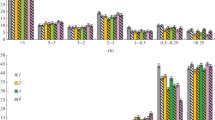Summary
Some physical and chemical properties of 1-to 2-mm aggregates obtained from casts and the burrow-wall material of the earthworm species Lumbricus terrestris, Aporrectodea longa, and Aporrectodea caliginosa were determined in order to show the effects of earthworms on the stabilization of soil aggregates. The results were compared with those of the natural soil from the Ap horizon of a Parabraunerde (Luvisol, FAO). Both the tensile strength and the water stability of aggregates from casts and burrow-wall material were reduced compared with those of the natural aggregates but were increased compared with those of remoulded aggregates. These results indicate that to a great extent existing bonds are destroyed by earthworm ingestion. Nevertheless, earthworm activities are advantageous for the stabilization of reformed aggregates. The coarse sand fraction is reduced by selective ingestion by earthworms. The organic C content is increased by 4.1–21.0% for burrow-wall material and by 21.2–43.0% for casts. The carbonate content of aggregates from casts and burrow-wall material of L. terrestris was reduced by more than 50%, while that of A. longa showed no noticeable changes and that of A. caliginosa was increased by more than 60%. The total content of polysaccharides was increased by 35–87% for casts and by 33–46% for the burrow-wall material of all earthworm species. The most frequently detected monosaccharides were glucose, galactose, and glucosamine. L. terrestris appeared to have the strongest effect on the interparticle bonding of the reformed aggregates, measured both as tensile strength and water stability, followed by A. longa and A. caliginosa.
Similar content being viewed by others
References
Anderson TH (1991) Bedeutung der Mikroorganismen für die Bildung von Aggregaten im Boden. Z Pflanzenernähr Bodenkd 154:409–416
Barois I, Lavelle P (1986) Changes in respiration rate and some physicochemical properties of a tropical soil during transit through Pontoscolex corethrurus (Glossoscolecidae, Oligochaeta). Soil Biol Biochem 18:539–541
Bouché MB (1977) Stratégies lombriciennes. Ecol Bull (Stockholm) 25:122–132
Chenu C, Guérif J (1991) Mechanical strength of clay minerals as influenced by an absorbed polysaccharide. Soil Sci Soc Am J 55:1076–1080
Darwin C (1881) The formation of vegetable mould through the action of worms with observations on their habits. Murray, London
Dexter AR (1978) Tunnelling in soil by earthworms. Soil Biol Biochem 10:447–449
Dexter AR, Kroesbergen B (1985) Methodology for determination of tensile strength of soil aggregates. J Agric Eng Res 31:139–147
Dexter AR, Horn R, Kemper WD (1988) Two mechanisms for age-hard-ening of soil. J Soil Sci 39:163–175
Edwards CA, Lofty JR (1977) Biology of earthworms, 2nd edn. Chapman and Hall, London
Ehlers W (1975) Observations on earthworm burrows and infiltration on tilled and untilled loess soil. Soil Sci 119:242–249
Hartge KH, Horn R (1989) Die physikalische Untersuchung von Böden, 2nd edn. Enke Verlag, Stuttgart
Hayes MHB (1983) Darwin's “vegetable mould” and some modern concepts of humus structure and soil aggregation. In: Satchell JE (ed) Earthworm ecology. Chapman and Hall, London New York, pp 19–33
Kemper WD, Rosenau RC (1986) Aggregate stability and size distribution. In: Klute A (ed) Methods of soil analysis, Part 1. Physical and mineralogical methods, 2nd eds. Agronomy 9, Am Soc Agron, Madison, Wisconsin, pp 425–442
Lal R, Akinremi OO (1983) Physical properties of earthworm casts and surface soil as influenced by management. Soil Sci 135:114–122
Lal R, de Vleeschauwer D (1982) Influence of tillage methods and fertilizer application on chemical properties of worm castings in a tropical soil. Soil Tillage Res 2:37–52
Lee KE (1985) Earthworms — Their ecology and relationships with soils and land use. Academic Press, Sydney
Lee KE, Foster RC (1991) Soil fauna and soil structure. Aust J Soil Res 29:745–776
Marinissen JCY, Dexter AR (1990) Mechanisms of stabilization of earthworm casts and artificial casts. Biol Fertil Soils 9:163–167
Martens DA, Frankenberger WT Jr (1990) Determination of saccharides by high performance anion-exchange chromatography with pulsed amperometric detection. Chromatographia 29:7–12
McKenzie BM, Dexter AR (1987) Physical properties of casts of the earthworm Aporrectodea rosea. Biol Fertil Soils 5:152–157
Schrader S, Joschko M (1991) A method for studying the morphology of earthworm burrows and their function in respect to water movement. Pedobiologia 35:185–190
Shipitalo MJ, Protz R (1988) Factors influencing the dispersibility of clay in worm casts. Soil Sci Soc Am J 52:764–769
Shipitalo MJ, Protz R (1989) Chemistry and micromorphology of aggregation in earthworm casts. Geoderma 45:357–374
Swaby RJ (1949) The influence of earthworms on soil aggregation. J Soil Sci 1:195–197
Author information
Authors and Affiliations
Rights and permissions
About this article
Cite this article
Zhang, H., Schrader, S. Earthworm effects on selected physical and chemical properties of soil aggregates. Biol Fertil Soils 15, 229–234 (1993). https://doi.org/10.1007/BF00361617
Received:
Issue Date:
DOI: https://doi.org/10.1007/BF00361617




